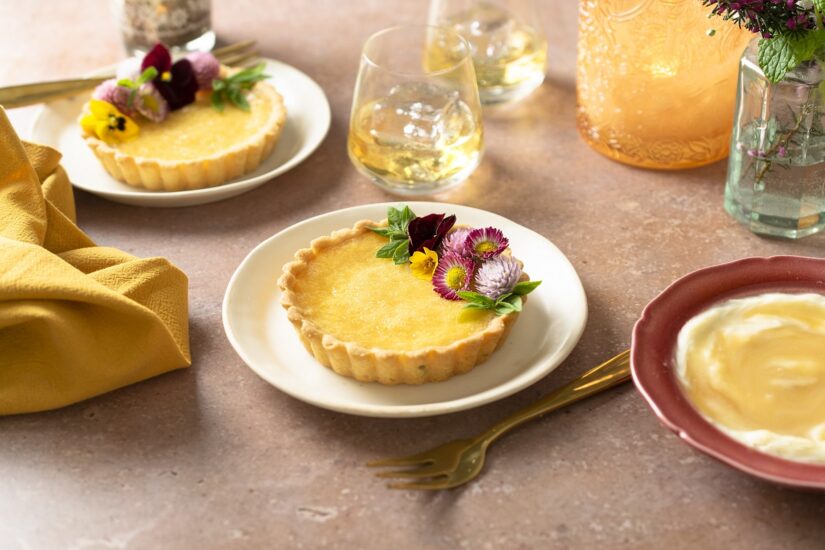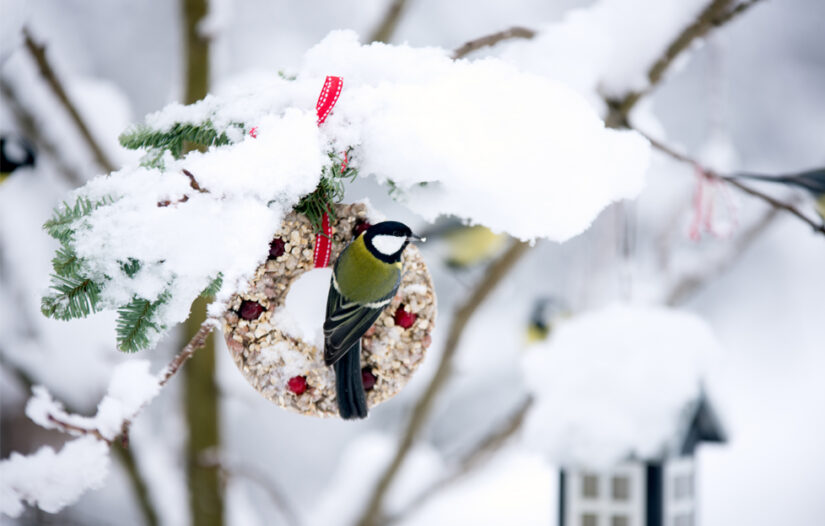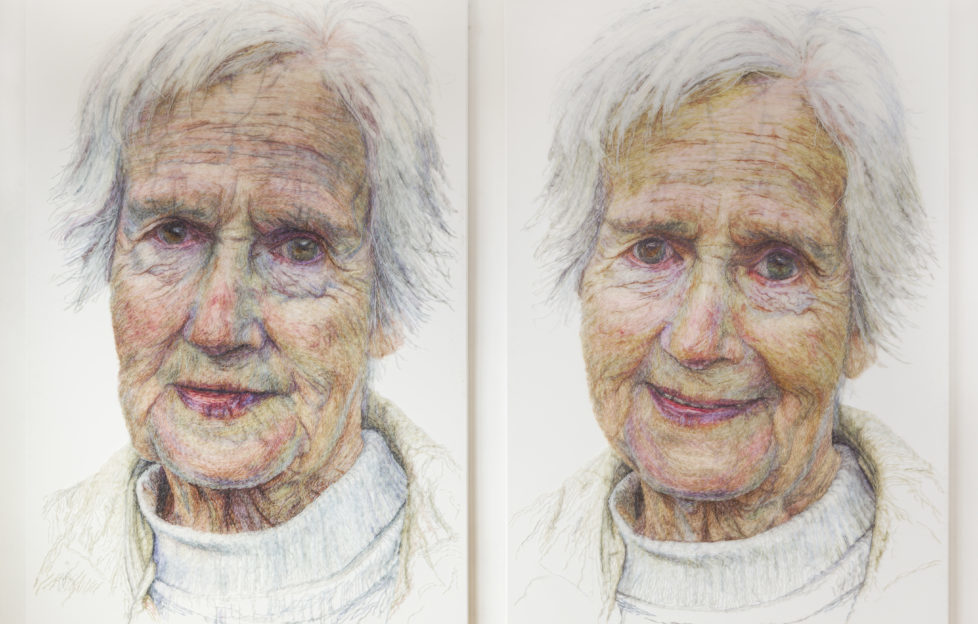
Jennie Dutton has an exhibition at The Knitting and Stitching show and we catch up with her ahead of the event.
Jenni, can you tell us a little about yourself and how you became a textile artist?
As long as I can remember I have always made things; weaving nests for imaginary birds as a child, making faces out of wet concrete I found on a building site in Cyprus where my father was stationed in the early 1960s. And always drawing and painting. When I was at boarding school in England and very homesick, drawing was my only solace. I copied artists drawings in the dusty school library and experimented with making clothes out of old school uniform, customising my own clothes to find some individuality in my daily existence. I was encouraged to apply for art school in London after I left school and I followed a fine art degree for four years until 1972. I was mainly painting abstract compositions, but alongside that, I designed and made my own clothes, experimented with patchwork and weaving. (It was the 1970s!)
I became an art teacher and was head of an art department in a large secondary school which gave me little time to exhibit, but plenty of time to research other artists and to experiment with different materials, tools, and techniques.
When I left teaching I began to experiment with making conceptual clothing, amongst which were dresses made from human hair, corsets made from fish skins. Influenced by fairy tales, myths, and legends, the work became darker with currents of unease. I made a series of shoes, again experimenting with different man-made and natural materials. All of this work can be seen on my website.
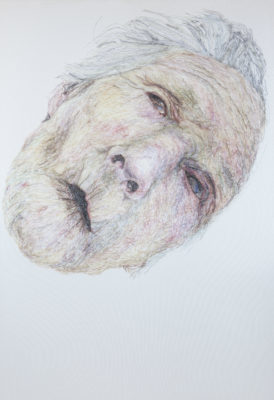
Your exhibition The Dementia Darnings is an intimate and intensely personal portrayal of your mother who had dementia, and for whom you were caring much of the time that you were developing the work. How did The Dementia Darnings come about and was the process of making them cathartic?
The Darnings were started in 2011 whilst I was a carer for my mum who was developing dementia. As I began to have some understanding of the illness and how it developed, we explored ways of engaging with the past, often looking at old photo albums. I started to use stitching to ‘draw’ likenesses of family members onto a sculpture of a long dress I had made from dress netting. She recognised these familiar faces and enjoyed watching me create these simple portraits.
I then challenged myself to choose one of the images and made a very large portrait using this stitching techniques on fine netting suspended from the ceiling in my studio. I used a familiar photo of my mum taken during the second world war.
I developed the piece ‘Mum with a Spotty Bow’ as though I was making a cross-hatched tonal drawing. It was originally made without the canvas support, just suspended from the ceiling, but it distorted and stretched, so fixing the Darning, (as it then became known) to a canvas support was the solution. This is how I presented all The Dementia Darnings after that, working into the netting stretched over a canvas.
The Dementia Darnings are made like drawings where crosshatched marks are built up on paper. I use a simple running stitch using threads of tapestry wool. The wool is made up of 4 strands twisted together. For the later portraits, I separated the lengths of wool into individual strands, ironed each strand to remove the kinks and used that to build up the shapes and form. This took much longer to develop the form, but it did achieve the delicacy and fragility of the subject I was trying to describe. I work from photographs and sew direct into the netting stretched over canvas. Each of the latest Darnings takes about 4 months to make. I think there is an intimacy in the way they are made, an intimacy that could not be reached through painting or drawing. I always feel these textile portraits are somehow built, it’s hard to explain. The making of the work is about time too, the slow build-up of the surface using the very physical medium of threads.
Naming them the ‘Darnings’ implies mending and repair and because I build up the individual stitches to create a mesh, it does resemble the technique of darning.
I do not use a sketchbook and do no preparatory work apart from finding and printing suitable photographs. I develop all the work on the canvas so that the work retains some freshness. I allow the piece to develop as it will and then I can emphasise some aspects over others as they emerge. However, I do use a sketchbook throughout the making of a piece as a journal to record ideas, thoughts, and photos of work in progress.
When I am sewing, I cover up sections of the canvas and the equivalent section on the photograph so I am not aware of the whole. This would distract me. They are both squared up, ensuring that the shapes, when enlarged from the photo onto the canvas, are accurate, so my time and attention is just taken with building the forms, matching the colours and eventually it will all evolve into a totally new rendering of the portrait I have been working on. I am usually very surprised by the outcome, an aspect of the work becomes evident during the months I have spent working without having seen the whole piece.
There is an element of meditation when I am making the work, sometimes I lose myself as I sew intuitively, referring back and forth from the photo to the canvas without thinking too much along the way. My intention is to forget that it is a face with features, so I can just respond to the visual elements.
Sometimes when a piece is completed, I will then remove a lot of the threads, so I am able to develop a concept; of ageing, of loss, or deterioration, sometimes even cutting into the fine netting, (bobinette) which is supporting the sewn threads, further emphasising the frailty of the subject matter. Or I may add dramatic trailing threads so the image looks like it is unravelling.
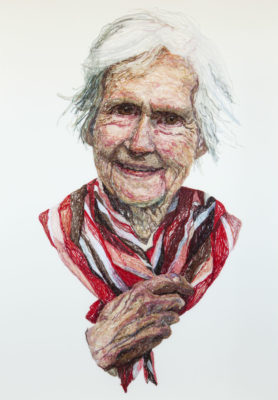
What kind of reaction have you had to The Dementia Darnings?
Well, this has been the most extraordinary aspect to the work and one that continues to move me. People are genuinely moved as they have usually had some sort of experience of ageing whether it be in a relative of a friend. Here are some of the comments I have collected:
“This exhibition stirs up so much for me as a 57 year old with my 87 year old mum in a dementia care home – we are all a work in progress. Delicate, resourceful, resilient, the essence of being human – captured in these Darnings.”
” Beautiful Darnings. It brought up many reflections on my Grandma’s ageing and dementia – the tangled threads, gradual fading. And I’m here with my mother, her daughter.”
“Riveting and profoundly moving. The Dementia Darnings are so strong that one forgets the actual skill and techniques used and can just be overwhelmed with an awareness of life lived and a person loved.”
“Never have I been so moved by a work of art as by these wonderful images of your mother. The great love which must have inspired you is matched by the brilliance of the conception and execution. It is a privilege to have seen them. Than yo
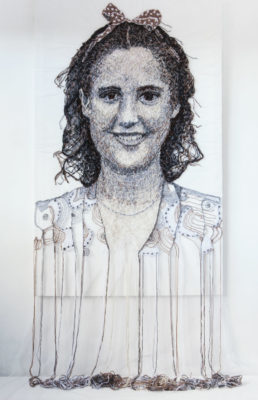
What’s next for you after The Knitting & Stitching Shows this autumn?
I have a solo show of the Darnings and some of my new work, The Absurd Sewn Selfies
at Bridport Arts Centre in Dorset in January and February 2019. Then I am part of a group show in Oxford at OVADA. I am part of a group, The Museum For Object Research, and the show is called Neither Use Nor Ornament. I have just had work exhibited in China and have had several requests to exhibit there but need to arrange this when it all fits together. I then intend to spend some time developing my new series, The Absurd Sewn Selfies – an exploration of ageing and the bonkers-ness that goes with it! Power to the oldies!
www.jennidutton.com
Jenni Dutton’s exhibition, The Dementia Darnings, is at the Textile Galleries at The Knitting & Stitching Show at Alexandra Palace and Harrogate from 11th-14th October 2018
www.theknittingandstitchingshow.com/london/
www.theknittingandstitchingshow.com/harrogate/

